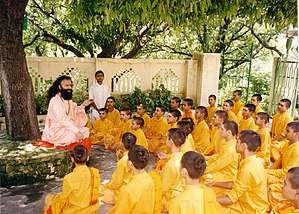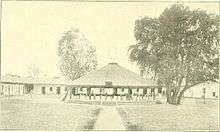Gurukula
A gurukula or gurukulam (Sanskrit: गुरुकुल, romanized: gurukula) was a type of education system in ancient India with shishya ('students' or 'disciples') living near or with the guru, in the same house.[1] The guru-shishya tradition is a sacred one in Hinduism and appears in other religious groups in India, such as Jainism, Buddhism and Sikhism. The word gurukula is a combination of the Sanskrit words guru ('teacher' or 'master') and kula ('family' or 'home').[2][3] Before the arrival of British rule, they served as South Asia's primary educational system. The term is also used today to refer to residential monasteries or schools operated by modern gurus.[4] The proper plural of the term is gurukulam, though gurukulas and gurukuls are also used in English and some other Western languages.

The students learn from the guru and help the guru in his everyday life, including carrying out of mundane daily household chores. However, some scholars suggest that the activities are not mundane and very essential part of the education to inculcate self-discipline among students.[5] Typically, a guru does not receive or accept any fees from the shishya studying with him as the relationship between a guru and the shishya is considered very sacred.[6]
At the end of one's education, a shishya offers the guru dakshina before leaving the gurukula.[3] The gurudakshina is a traditional gesture of acknowledgment, respect and thanks to the guru, which may be monetary, but may also be a special task the teacher wants the student to accomplish.[3] While living in a gurukula, the students would be away from their home from a period of months to years at a stretch and disconnected from their family completely.
History

The gurukula system of education has been in existence since ancient times. The Upanishads mention multiple gurukulam, including that of guru Drona at Gurgaon.[2] The Bhrigu Valli (a discourse on the Brahman) is said to have taken place in Guru Varuni's gurukula. The vedic school of thought prescribes the gurukula (sacred rite of passage) to all individuals before the age of 8 at least by 12. From initiation until the age of 25 all individuals are prescribed to be students and to remain unmarried, a celibate.
Gurukulam were supported by public donations. This was followed by the many following Vedic thoughts making gurukula one of the earliest forms of public school centres.
Revival of the gurukula system
By the colonial era, the gurukula system was on a steep decline in India. Dayananda Saraswati, the founder of Arya Samaj and Swami Shraddhanand, were the pioneers of the modern gurukula system, who in 1886 founded now-widespread Dayanand Anglo-Vedic Public Schools and Universities.[7][8][9]
In 1948, Shastriji Maharaj Shree Dharamjivan das Swami followed suit and initiated first Swaminarayan gurukula in Rajkot in Gujarat state of India. Recently, several gurukulam have opened up in India as well as overseas with a desire to uphold tradition.
Today various gurukulas still exist in India, and researchers have been studying the effectiveness of the system through those institutions.[5]
Gurukula out of India
The Gurukula system of education is available outside of India as well. They are known as Gurukula.
Gurukula in Belgium
At the Jain Culture Center of Antwerp, children between the ages of 8 till 16 study Vedic mathematics, Art, Music, as well as Vedic Astrology, Jyotishi, Sanskrit and Yoga.
Children participate in this Gurukula during holiday times at the traditional schools, for a week in October / November, 2 weeks during Easter break, and 1 month during summer break.
See also
References
- Yin Cheong Cheng; Kwok Tung Tsui; King Wai Chow; Magdalena Mo Ching Mok, eds. (2002). Subject Teaching and Teacher Education in the New Century: Research and Innovation. Springer. p. 194. ISBN 978-962-949-060-7.
- True story behind Gurugram
- www.academia.edu - Gurukula: A Family with Difference - An Exposition of the Ancient Indian System of Education
- "नित्यानंद ने 70 लोगों को दी दीक्षा" [Nithyananda initiated 70 people]. Dainik Jagran (in Hindi). Retrieved 7 April 2018.
... [C]hildren of Swami Nithyananda's gurukul school demonstrated ....]
- Joshi, Ankur; Gupta, Rajen K. (July 2017). "Elementary education in Bharat (that is India): insights from a postcolonial ethnographic study of a Gurukul". International Journal of Indian Culture and Business Management. 15 (1): 100–120.
- Joshi, Ankur; Bindlish, Puneet; Verma, Pawan Kumar (2014-12-01). "A Post-colonial Perspective towards Education in Bharat". Vision. 18 (4): 359–363. doi:10.1177/0972262914552171. ISSN 0972-2629.
- Gurukula Patrika, April–July, 1940-41, Ank 10, (12 June 1940), P.1
- Madalsa Ujjwal, 2008, "Swami Dayanand Saraswati Life and Ideas", Book Treasure Publications, Jodhpur, PP.96-97
- Gunjun H. Shakshi, 1971, "Social and Humanistic Life in India", Abhinav Publications, Delhi, PP.122-124.